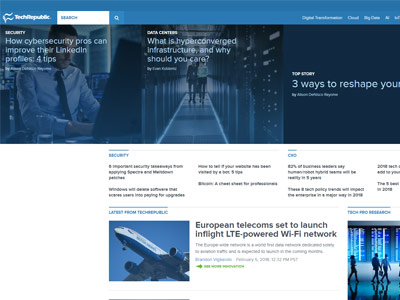Explore Thought-Provoking Articles on the Best tech blog for Tech Lovers
Explore Thought-Provoking Articles on the Best tech blog for Tech Lovers
Blog Article
Comprehending the Rise of Side Computing in Today's Digital Globe
In the quickly progressing landscape of modern technology, edge computer becomes an essential pressure, reshaping how information is refined and used. This paradigm shift is driven by the spreading of IoT tools and a rising need for rapid data processing. By transitioning information administration closer to the resource, edge computer addresses vital latency concerns while maximizing transmission capacity use and boosting safety and security actions. As markets pivot in the direction of smarter, more effective systems, comprehending the nuances and effects of this technical improvement becomes vital. What does this mean for future advancements and the digital environment in its entirety?
What Is Side Computing
Side computer, although a relatively recent innovation in the world of innovation, essentially changes just how data is processed and handled by bringing computation and information storage closer to the location where it is required. Unlike standard cloud computing versions, which often depend on centralized data centers that can be geographically remote, edge computing decentralizes data handling. This closeness reduces latency, improves real-time information processing, and boosts the overall individual experience by making certain faster reaction times.
At its core, edge computing includes a network of localized devices and infrastructure, such as sensors, routers, and portals, with the ability of processing information at or near the resource. This localized processing capacity is specifically vital for applications calling for prompt information analysis, such as self-governing automobiles, commercial automation, and clever cities. In addition, by unloading data handling tasks from central web servers, side computer reduces data transfer needs and boosts information personal privacy and safety, as sensitive information can remain on-site as opposed to going across comprehensive networks.

Trick Drivers of Fostering
Several variables are propelling the fostering of edge computing in today's digital landscape. Side computing addresses this need by enabling data processing closer to the information source, decreasing latency and enhancing real-time decision-making abilities.
One more substantial motorist is the need for improved transmission capacity effectiveness. Central cloud systems can come to be overloaded with the large quantity of information produced by IoT devices, leading to bottlenecks (Best tech blog). By refining data at the edge, companies can minimize network congestion and boost total system efficiency
In addition, security and privacy concerns are pushing organizations toward edge computing. By processing delicate data in your area, companies can mitigate threats connected with information transmission and direct exposure to possible cyber threats.
The increase of applications requiring real-time handling, such as self-governing cars and augmented reality, likewise requires the fast response times that edge computing provides. Collectively, these drivers are making side calculating an important part of modern-day IT infrastructure, leading the means for its prevalent adoption across various markets.
Benefits Over Cloud Computer
Just how does side computer distinguish itself from standard cloud computer? Mainly, edge computing brings data processing closer to the resource of information generation, frequently on regional gadgets or neighboring servers, rather than relying on centralized data.
Furthermore, side computing enhances data transfer efficiency (Best tech blog). By refining information in your area, only the needed data is transmitted to the cloud for further analysis or storage space, decreasing the quantity of information that traverses the network. This not only alleviates network blockage yet also reduces data transmission prices
Side computer likewise offers improved information personal privacy and security. Delicate information can be processed locally without being sent to the cloud, decreasing the direct exposure to prospective cyber threats. This is specifically advantageous for industries handling secret information, such as health care and economic services.
Additionally, side computer guarantees higher strength and dependability. Local handling enables continued operation also when connectivity to the cloud is endangered, preserving vital functions and solutions regardless of prospective network interruptions. These advantages jointly show side computer's transformative capacity in enhancing performance and safety in electronic ecosystems.
Considerations and challenges
While side computer offers numerous benefits, it also provides unique challenges and considerations that must be resolved to completely realize its potential. Furthermore, handling and keeping track of a decentralized network of edge tools can be complicated, needing advanced devices and techniques to link make sure seamless procedure and upkeep. Best tech blog.
Another consideration is the scalability of side computing services. As the variety of connected devices grows, so does the demand for processing power at the edge, which can lead to resource restrictions. Organizations must meticulously prepare their infrastructure to suit this growth without endangering efficiency or efficiency.
Interoperability is an additional important variable. With different software and hardware parts included, making certain compatibility and seamless integration can be difficult. Standardization initiatives are vital to promote communication between inconsonant systems.
Future Patterns in Edge Computing
Preparing for the future, side computer is positioned to change various sectors by allowing faster information processing and decreasing latency. As the volume of information produced by IoT devices continues to expand, edge computer will certainly become progressively important in managing this increase successfully.
Another arising pattern is the advancement of edge-native applications created specifically to leverage the distinct abilities of edge computing. These applications will certainly optimize performance and resource use, resulting in enhanced effectiveness throughout numerous fields. Innovations in use this link 5G modern technology will certainly even more boost edge computing by giving the needed infrastructure for high-speed, low-latency communication in between gadgets and edge nodes.
Verdict
Edge computing's surge is driven by the proliferation of IoT tools and the requirement for real-time information processing, which enhances efficiency by minimizing latency and decentralizing information administration. This strategy alleviates bandwidth ineffectiveness and protection concerns, facilitating improvements in applications like self-governing automobiles and wise cities. Regardless of difficulties such as framework complexity and combination, the future of side computer promises a more receptive electronic ecosystem, with proceeded innovations shaping its evolution and broadening its applicability throughout industries.
Side computing, although a reasonably recent advancement official site in the realm of modern technology, essentially changes just how information is refined and taken care of by bringing calculation and data storage closer to the place where it is required. Unlike conventional cloud computer models, which commonly rely on central information facilities that can be geographically distant, side computing decentralizes information handling. Furthermore, by offloading information handling jobs from main web servers, edge computer decreases bandwidth demands and boosts data privacy and safety and security, as sensitive info can continue to be on-site rather than traversing comprehensive networks.

Report this page